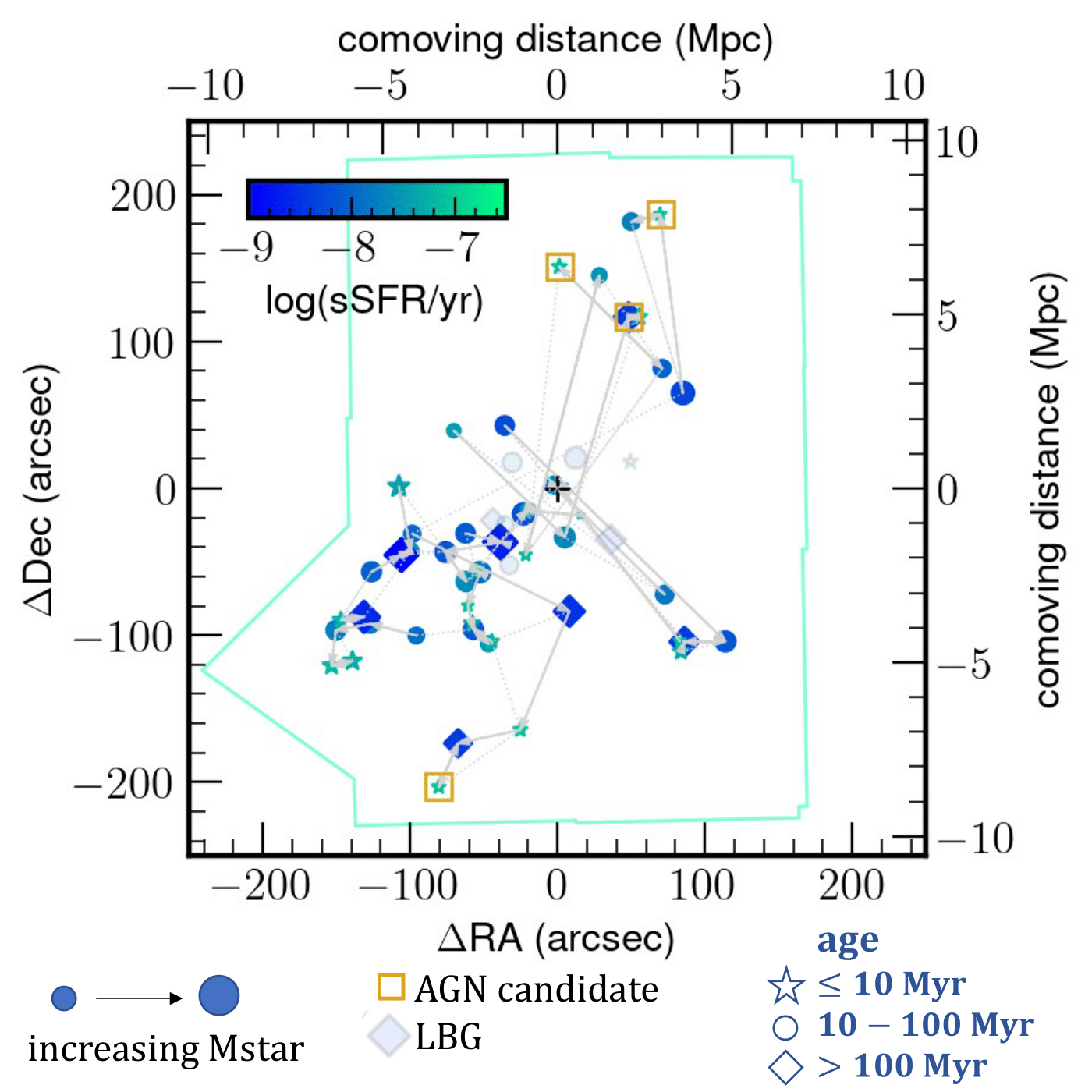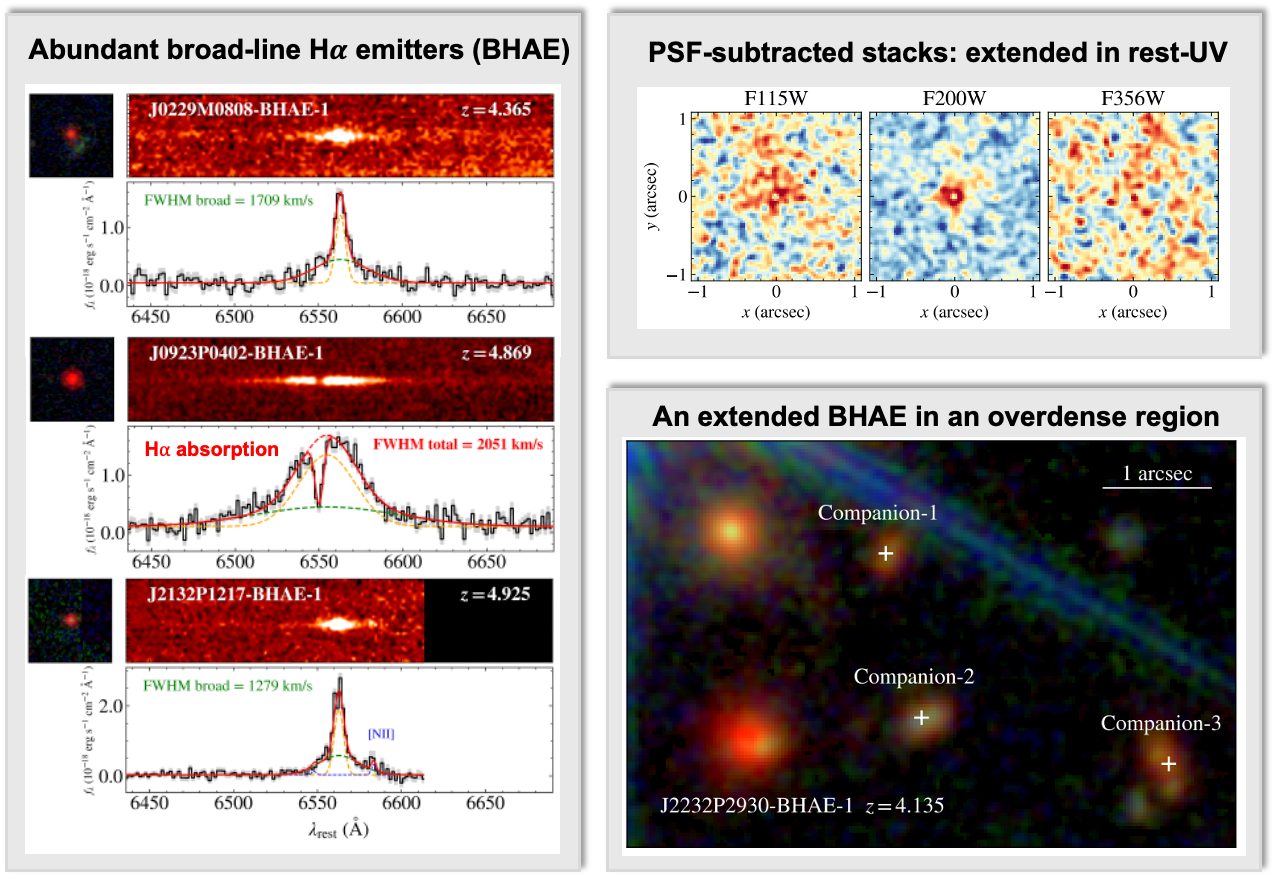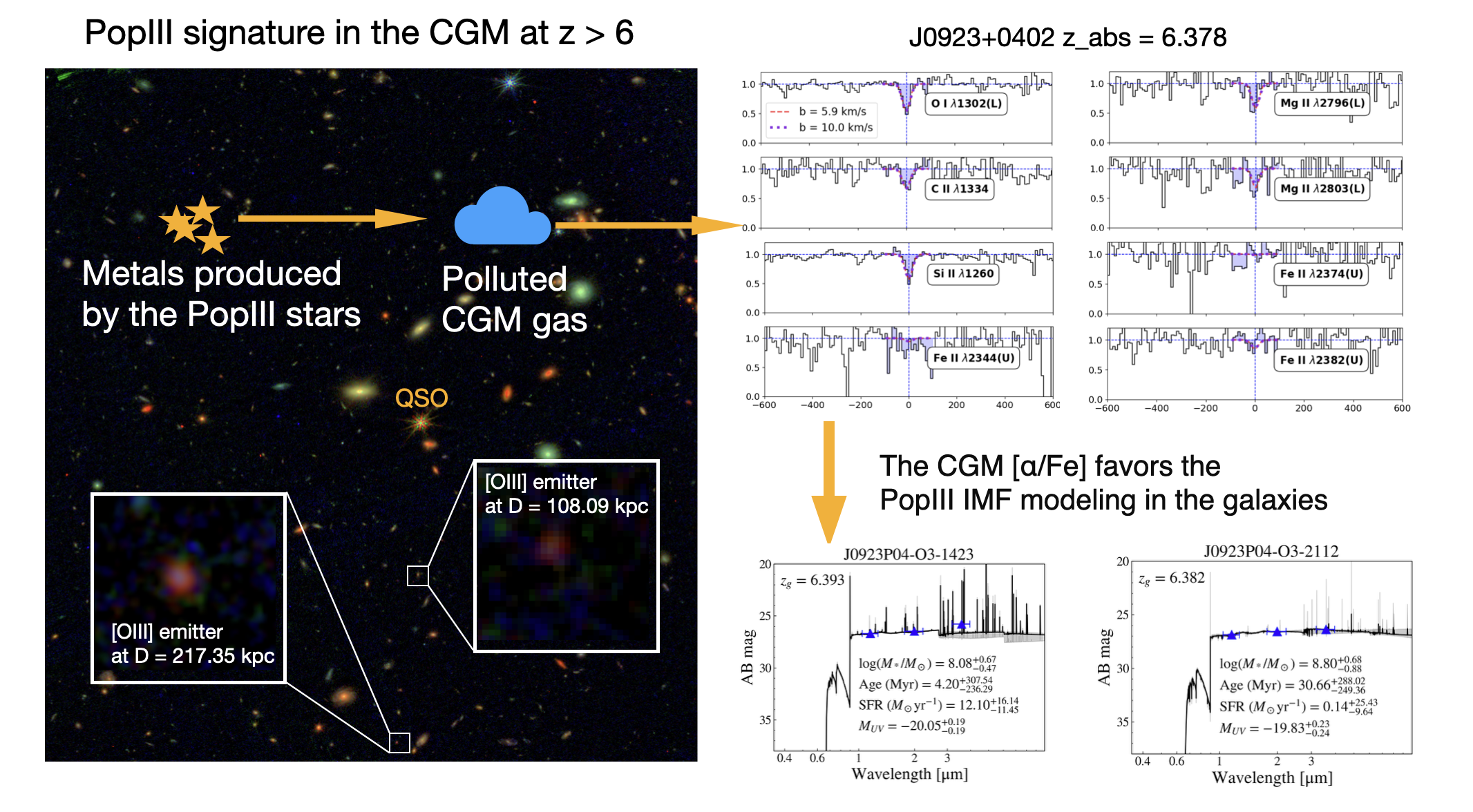Publications
Check out ASPIRE's latest published results here!
What have we learned from ASPIRE so far?

The Quest to Find Quasar-Anchored Protoclusters: J0305-3150 at z=6.6
Decades of searching for galaxy overdensities around quasars using traditional photometric selection methods have yielded inconclusive results about whether quasars trace large scale structure. Champagne et al. (2024a) reports an astounding 53 member galaxies in a protocluster associated with a z=6.6 ASPIRE quasar, spectroscopically confirmed via [OIII]. This filamentary structure spans over 15 cMpc on the sky and contains a population of [OIII] emitters with anomalously low equivalent widths, perhaps signifying a suppression of SFR from quasar feedback or intrinsically bursty star formation histories.
Characterizing Galaxy Evolution in Quasar-Anchored Protoclusters: J0305-3150 at z=6.6
Champagne et al. (2024b) goes into greater detail about the physical properties of the [OIII] emitters identified in the z=6.6 quasar field. They find that, on average, galaxies with the highest stellar masses and lowest specific star formation rates dominate the densest regions of the protocluster filaments, which are in turn surrounded by lower-mass galaxies experiencing a ramping-up of their recent star formation. Further, there is tentative evidence for 5 AGN hosts all located on the outskirts of the protocluster; together these lend credence to the idea of inside-out growth fueled by cold gas inflow along cosmic filaments.
Constraining Reionization with ASPIRE
The Lyman-alpha forest imprinted in the high-redshift quasar spectrum is a powerful tool to study the IGM ionization state during cosmic reionization. Jin et al. (2024) use the Lyman-alpha forest spectrum of 14 ASPIRE quasars to measure IGM transmission around [OIII] emitters from ASPIRE, and find the IGM transmission around [OIII] emitters is significantly higher than IGM patches where no [OIII] emitters are detected. IGM patches around [OIII] emitters reach the same IGM transmission at least 23 Myr ahead of IGM patches where no [OIII] emitters are detected, supporting an earlier reionization around [OIII] emitters.
Hunting for Mysterious Little Red Dots at z=4-5
JWST’s discovery of abundant low-luminosity AGNs in the early universe, termed "little red dots," is crucial for understanding early black hole growth and BH-galaxy coevolution. Within 25 ASPIRE fields, Lin et al. (2024) identify 16 broad-line Hα-emitters at z = 4-5, suggesting black hole masses of 10-100 million solar masses. Their stacked image reveals extended structures in the rest-frame UV, which likely traces stellar light from host galaxies: a new discovery in the field of little red dots. Three emitters show blueshifted absorption troughs indicating the presence of high-density gas, and there is also possible evidence of clustering.
The Impact of Galaxies on the CGM Metal Enrichment at z>6
Discovering the signatures of the first objects (stars, black holes, and galaxies) is one of the major goals of JWST. Zou et al. (2024) characterized the multiphase circumgalactic medium (CGM) and galaxy properties at z = 6.0-6.5 in four quasar fields using ASPIRE and VLT/Xshooter data. The results found that the α elements to iron ([α/Fe]) ratio in the CGM gas at z>6 exhibits an enhancement. Their modeling of the galaxy’s chemical abundance favors a top-heavy stellar initial mass function, and the Pop III IMF can possibly explain the observed value in the CGM. We may be witnessing the contribution of the first generation Pop III stars to the CGM at the end of the reionization epoch.
JWST Discovers an Overdensity around a Metal Absorption-selected Galaxy at z~5.5
Theoretical models suggest a strong correlation between the strengths of early metal absorbers and the local galaxy overdensity, however, direct observational evidence is still lacking. Wu et al. (2023) utilized JWST/NIRcam WFSS observations to search for metal-associated galaxies by detecting their rest-frame [OIII] + Hβ emission. Seven galaxies are confirmed to be associated with a MgII absorber (rest-frame equivalent width = 0.7 Å) at z=5.428. This result suggests that early metals may be generated and reside in an overdense environment.
A Candidate Protocluster around a z=6.6 Quasar
Wang et al. (2023) presents an overdensity of [OIII] emitters a factor of ~10 above the blank field around J0305-3150, a z=6.6 quasar known to be overdense in LBGs, LAEs, and [CII] emitters (Farina et al. 2017, Ota et al. 2018, Venemans et al. 2020, Champagne et al. 2023). A spectroscopically confirmed candidate protocluster now reveals itself with NIRCam WFSS, as well as several serendipitously-discovered overdensities at z~5.5.
Measuring Black Hole Masses with Hβ
Constraining SMBH masses at high redshift is difficult with single epoch measurements, demanding more accurate calibrations with multiple emission lines. Yang et al. (2023) presents the first accurate Hβ-based SMBH measurements for the ASPIRE sample, finding consistency with previous MgII-based masses. The sample shows a remarkable diversity in Fe II emission strength and [OIII] line profiles, hinting at further exciting results to come with the delivery of the full dataset.







